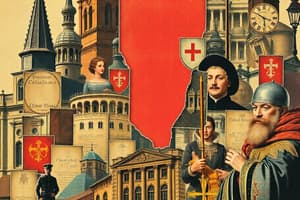Podcast
Questions and Answers
What was a consequence of the demographic shift on the feudal system?
What was a consequence of the demographic shift on the feudal system?
- Labor became more abundant and cheaper
- The feudal system was immediately abolished
- The power of the feudal lords was strengthened
- Serfs and peasants gained greater bargaining power (correct)
What was a result of the growth of urban centers during the Renaissance?
What was a result of the growth of urban centers during the Renaissance?
- The rise of the feudal system
- A decline in artistic and scientific innovations
- The suppression of trade and commerce
- The flourishing of art, science, and culture (correct)
How did the rise of the merchant class contribute to the erosion of feudal hierarchies?
How did the rise of the merchant class contribute to the erosion of feudal hierarchies?
- By creating a new, rigid social class system
- By allowing wealth and merit to determine social status (correct)
- By strengthening the power of the nobility
- By abolishing social hierarchies altogether
What was a key aspect of the Treaty of Lodi in 1454?
What was a key aspect of the Treaty of Lodi in 1454?
What was a consequence of the shift in power from rural lords to urban centers?
What was a consequence of the shift in power from rural lords to urban centers?
Why was the spread of Renaissance ideas initially slow beyond Italy?
Why was the spread of Renaissance ideas initially slow beyond Italy?
What was a key factor in the consolidation of small political units into larger states?
What was a key factor in the consolidation of small political units into larger states?
What emerged as a key aspect of civic life during the Renaissance?
What emerged as a key aspect of civic life during the Renaissance?
What was the primary focus of the medieval worldview?
What was the primary focus of the medieval worldview?
What was the significance of the Silk Road during the Renaissance?
What was the significance of the Silk Road during the Renaissance?
What was the impact of the Black Death on European society?
What was the impact of the Black Death on European society?
Who were instrumental in translating and promoting ancient works during the Renaissance?
Who were instrumental in translating and promoting ancient works during the Renaissance?
What was the primary characteristic of the Renaissance worldview?
What was the primary characteristic of the Renaissance worldview?
What was the role of Islamic civilization during the Renaissance?
What was the role of Islamic civilization during the Renaissance?
What was the result of the influx of new ideas during the Renaissance?
What was the result of the influx of new ideas during the Renaissance?
What was the primary characteristic of the social transformation during the Renaissance?
What was the primary characteristic of the social transformation during the Renaissance?
Flashcards are hidden until you start studying
Study Notes
The Renaissance: An Overview
- The Renaissance was a transformative period in European history, spanning roughly from the 14th to the 17th century.
- It began on the Italian peninsula and was characterized by a resurgence of interest in classical knowledge of ancient Greece and Rome.
- The Renaissance profoundly shaped the modern Western worldview and laid the foundation for many aspects of contemporary Western society.
Exchange of Ideas and Knowledge
- The Renaissance marked a reawakening of Europe's intellectual and artistic heritage, facilitated by the rediscovery of classical texts and humanism.
- Scholars like Petrarch and Erasmus played a crucial role in translating and promoting ancient works, emphasizing human potential and achievement.
- The Silk Road was a conduit for the transfer of ideas, scientific knowledge, and technological innovations from Eastern cultures to Europe.
- Islamic civilization, strategically positioned on the Silk Road, became a center of learning, preserving and expanding upon Greek and Roman knowledge.
Transformation of Social Systems
- The devastating Black Death led to a demographic shift, weakening the feudal system and giving serfs and peasants greater bargaining power.
- Many left rural areas for cities, where opportunities in trade and commerce were growing, accelerating urbanization.
- Urban centers like Florence, Venice, and Genoa emerged as thriving hubs of trade, banking, and culture.
- The rise of the merchant class and the increased importance of trade contributed to the erosion of rigid feudal hierarchies.
Political Shifts
- The Renaissance saw the consolidation of small political units into larger states, laying the groundwork for the modern nation-state.
- Monarchs began to centralize power, often through strategic marriages, alliances, and treaties.
- The Treaty of Lodi in 1454 maintained a balance of power among the Italian city-states, allowing them to focus on economic expansion.
- The rise of diplomacy and the weakening of the feudal system shifted the locus of power from rural lords to urban centers.
Spread of Renaissance Ideas
- The spread of Renaissance ideas beyond Italy was initially slow due to entrenched feudal systems and the strong influence of the Roman Catholic Church.
- However, several factors contributed to the eventual dissemination of Renaissance humanism across Europe.
Studying That Suits You
Use AI to generate personalized quizzes and flashcards to suit your learning preferences.




